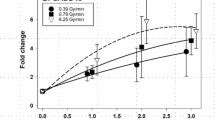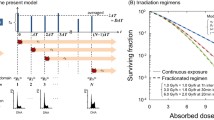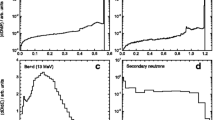Abstract
Purpose
In order to clarify the biological response of tumor cells to proton beam irradiation, sublethal damage recovery (SLDR) and potentially lethal damage recovery (PLDR) induced after proton beam irradiation at the center of a 10 cm spread-out Bragg peak (SOBP) were compared with those seen after X‑ray irradiation.
Methods
Cell survival was determined by a colony assay using EMT6 and human salivary gland tumor (HSG) cells. First, two doses of 4 Gy/GyE (Gray equivalents, GyE) were given at an interfraction interval of 0–6 h. Second, five fractions of 1.6 Gy/GyE were administered at interfraction intervals of 0–5 min. Third, a delayed-plating assay involving cells in plateau-phase cultures was conducted. The cells were plated in plastic dishes immediately or 2–24 h after being irradiated with 8 Gy/GyE of X‑rays or proton beams. Furthermore, we investigated the degree of protection from the effects of X‑rays or proton beams afforded by the radical scavenger dimethyl sulfoxide to estimate the contribution of the indirect effect of radiation.
Results
In both the first and second experiments, SLDR was more suppressed after proton beam irradiation than after X‑ray irradiation. In the third experiment, there was no difference in PLDR between the proton beam and X‑ray irradiation conditions. The degree of protection tended to be higher after X‑ray irradiation than after proton beam irradiation.
Conclusion
Compared with that seen after X‑ray irradiation, SLDR might take place to a lesser extent after proton beam irradiation at the center of a 10 cm SOBP, while the extent of PLDR does not differ significantly between these two conditions.
Zusammenfassung
Zielsetzung
Zur Klärung der biologischen Reaktion von Tumorzellen auf eine Protonenbestrahlung wurden die Erholung von subletalen Schäden (SLDR; „sublethal damage recovery“) und die von potenziell letalen Schäden (PLDR; „potentially lethal damage recovery“), induziert nach Protonenbestrahlung in der Mitte eines 10-cm-Spread-out-Bragg-Peak (SOBP), untersucht und mit der nach Röntgenbestrahlung verglichen.
Methoden
Das Zellüberleben wurde in einem Kolonie-Assay mit EMT6- und HSG-Zellen („human salivary gland tumor“) bestimmt. Erstens wurden zwei Dosen mit 4 Gy/GyE (Äquivalentdosis) mit einem interfraktionellen Intervall von 0–6 h appliziert. Zweitens wurden fünf Fraktionen zu je 1,6 Gy/GyE in interfraktionellen Intervallen von 0–5 min verabreicht. Drittens wurde ein Test mit einer Reparaturzeit („delayed plating assay“) an Kulturen in der stationären Phase durchgeführt. Die Zellen wurden entweder sofort oder 2–24 h nach Bestrahlung mit 8 Gy/GyE-Röntgen- oder Protonenstrahlen in Kunststoffschalen ausplattiert. Des Weiteren untersuchten wir die Schutzwirkung des Radikalfängers Dimethylsulfoxid (DMSO) hinsichtlich der Schäden durch Röntgen- bzw. Protonenstrahlung, um den Anteil der indirekten Auswirkungen einer Bestrahlung abzuschätzen.
Ergebnisse
Im ersten und zweiten Experiment war die SLDR nach Protonenbestrahlung stärker supprimiert als nach Röntgenbestrahlung. Im dritten Experiment bestand bei keinem Zelltyp ein Unterschied in der PLDR zwischen Protonen- und Röntgenstrahlenexposition. Die DMSO-Schutzwirkung war nach Röntgenbestrahlung tendenziell höher als nach Protonenbestrahlung.
Schlussfolgerung
Verglichen mit der SLDR nach Röntgenbestrahlung findet nach Protonenbestrahlung in der Mitte des 10-cm-SOBP möglicherweise ein geringeres Maß an SLDR statt, während bei der PLDR kein signifikanter Unterschied zwischen beiden Strahlenarten besteht.








Similar content being viewed by others
References
Harrabi SB, Bougatf N, Mohr A et al (2016) Dosimetric advantages of proton therapy over conventional radiotherapy with photons in young patients and adults with low-grade glioma. Strahlenther Onkol 192:759–769. https://doi.org/10.1007/s00066-016-1005-9
Stromberger C, Cozzi L, Budach V et al (2016) Unilateral and bilateral neck SIB for head and neck cancer patients : intensity-modulated proton therapy, tomotherapy, and rapidarc. Strahlenther Onkol 192:232–239. https://doi.org/10.1007/s00066-016-0945-4
Adeberg S, Harrabi SB, Bougatf N et al (2016) Intensity-modulated proton therapy, volumetric-modulated arc therapy, and 3D conformal radiotherapy in anaplastic astrocytoma and glioblastoma. Strahlenther Onkol 192:770–779. https://doi.org/10.1007/s00066-016-1007-7
Gerweck LE, Kozin SV (1999) Relative biological effectiveness of proton beams in clinical therapy. Radiother Oncol 50:135–142
Paganetti H, Niemierko A, Ancukiewicz M et al (2002) Relative biological effectiveness (RBE) values for proton beam therapy. Int J Radiat Oncol Biol Phys 53:407–421
Iwata H, Ogino H, Hashimoto S et al (2016) Spot scanning and passive scattering proton therapy: relative biological effectiveness and oxygen enhancement ratio in cultured cells. Int J Radiat Oncol Biol Phys 95:95–102. https://doi.org/10.1016/j.ijrobp.2016.01.017
Antonelli F, Bettega D, Calzolari P et al (2001) Inactivation of human cells exposed to fractionated doses of low energy protons: relationship between cell sensitivity and recovery efficiency. J Radiat Res 42:347–359
Marshall TI, Chaudhary P, Michaelidesová A et al (2016) Investigating the implications of a variable RBE on proton dose fractionation across a clinical pencil beam scanned spread-out Bragg peak. Int J Radiat Oncol Biol Phys 95:70–77. https://doi.org/10.1016/j.ijrobp.2016.02.029
Elkind MM, Sutton-Gilbert H, Moses WB, Kamper C (1967) Sub-lethal and lethal radiation damage. Nature 214:1088–1092
Shibamoto Y, Ito M, Sugie C et al (2004) Recovery from sublethal damage during intermittent exposures in cultured tumor cells: implications for dose modification in radiosurgery and IMRT. Int J Radiat Oncol Biol Phys 59:1484–1490. https://doi.org/10.1016/j.ijrobp.2004.04.039
Phillips RA, Tolmach LJ (1966) Repair of potentially lethal damage in x‑irradiated HeLa cells. Radiat Res 29:413–432
Little JB, Hahn GM, Frindel E, Tubiana M (1973) Repair of potentially lethal radiation damage in vitro and in vivo. Radiology 106:689–694. https://doi.org/10.1148/106.3.689
Iliakis G (1988) Radiation-induced potentially lethal damage: DNA lesions susceptible to fixation. Int J Radiat Biol Relat Stud Phys Chem Med 53:541–584
Shibamoto Y, Takahashi M, Ono K et al (1985) Recovery from potentially lethal damage after X‑irradiation in three experimental tumors in mice. Jpn J Cancer Res 76:278–283
Sugie C, Shibamoto Y, Ito M et al (2006) Radiobiologic effect of intermittent radiation exposure in murine tumors. Int J Radiat Oncol Biol Phys 64:619–624. https://doi.org/10.1016/j.ijrobp.2005.03.032
Tomita N, Shibamoto Y, Ito M et al (2008) Biological effect of intermittent radiation exposure in vivo: recovery from sublethal damage versus reoxygenation. Radiother Oncol 86:369–374. https://doi.org/10.1016/j.radonc.2007.08.007
Rothkamm K, Krüger I, Thompson LH, Löbrich M (2003) Pathways of DNA double-strand break repair during the mammalian cell cycle. Mol Cell Biol 23:5706–5715
San Filippo J, Sung P, Klein H (2008) Mechanism of eukaryotic homologous recombination. Annu Rev Biochem 77:229–257. https://doi.org/10.1146/annurev.biochem.77.061306.125255
Utsumi H, Elkind MM (2001) Requirement for repair of DNA double-strand breaks by homologous recombination in split-dose recovery. Radiat Res 155:680–686
Liu M, Lee S, Liu B et al (2015) Ku-dependent non-homologous end-joining as the major pathway contributes to sublethal damage repair in mammalian cells. Int J Radiat Biol 91:867–871. https://doi.org/10.3109/09553002.2015.1075178
Ito A, Nakano H, Kusano Y et al (2006) Contribution of indirect action to radiation-induced mammalian cell inactivation: dependence on photon energy and heavy-ion LET. Radiat Res 165:703–712. https://doi.org/10.1667/RR3557.1
Wada M, Suzuki M, Liu C et al (2013) Modeling the biological response of normal human cells, including repair processes, to fractionated carbon beam irradiation. J Radiat Res 54:798–807. https://doi.org/10.1093/jrr/rrt012
Liu C, Kawata T, Zhou G et al (2013) Comparison of the repair of potentially lethal damage after low- and high-LET radiation exposure, assessed from the kinetics and fidelity of chromosome rejoining in normal human fibroblasts. J Radiat Res 54:989–997. https://doi.org/10.1093/jrr/rrt031
Shibamoto Y, Streffer C (1991) Estimation of the dividing fraction and potential doubling time of tumors using cytochalasin B. Cancer Res 51:5134–5138
Shibamoto Y, Streffer C, Fuhrmann C, Budach V (1991) Tumor radiosensitivity prediction by the cytokinesis-block micronucleus assay. Radiat Res 128:293–300
Furusawa Y, Fukutsu K, Aoki M et al (2000) Inactivation of aerobic and hypoxic cells from three different cell lines by accelerated (3)He-, (12)C- and (20)Ne-ion beams. Radiat Res 154:485–496
Uzawa A, Ando K, Koike S et al (2009) Comparison of biological effectiveness of carbon-ion beams in Japan and Germany. Int J Radiat Oncol Biol Phys 73:1545–1551. https://doi.org/10.1016/j.ijrobp.2008.12.021
Baek H‑J, Kim T‑H, Shin D et al (2008) Radiobiological characterization of proton beam at the National Cancer Center in Korea. J Radiat Res 49:509–515
Hahn GM, Little JB (1972) Plateau-phase cultures of mammalian cells: an in vitro model for human cancer. Curr Top Radiat Res Q 8:39–43
Nikitaki Z, Nikolov V, Mavragani IV et al (2016) Measurement of complex DNA damage induction and repair in human cellular systems after exposure to ionizing radiations of varying linear energy transfer (LET). Free Radic Res 50:64–S78. https://doi.org/10.1080/10715762.2016.1232484
Toshito T, Omachi C, Kibe Y et al (2016) A proton therapy system in Nagoya Proton Therapy Center. Australas Phys Eng Sci Med. https://doi.org/10.1007/s13246-016-0456-8
Yasui K, Toshito T, Omachi C et al (2015) A patient-specific aperture system with an energy absorber for spot scanning proton beams: verification for clinical application. Med Phys 42:6999–7010. https://doi.org/10.1118/1.4935528
Hashimoto S, Shibamoto Y, Iwata H et al (2016) Whole-pelvic radiotherapy with spot-scanning proton beams for uterine cervical cancer: a planning study. J Radiat Res 57:524–532. https://doi.org/10.1093/jrr/rrw052
Agostinelli S, Allison J, Amako K et al (2003) Geant4 — a simulation toolkit. Nucl Instrum Methods Phys Res A 506:250–303. https://doi.org/10.1016/S0168-9002(03)01368-8
Paganetti H (2005) Interpretation of proton relative biological effectiveness using lesion induction, lesion repair, and cellular dose distribution. Med Phys 32:2548–2556. https://doi.org/10.1118/1.1949807
Seltzer SM, Bartlett DT, Burns DT et al (2011) The International Commission on Radiation Units and Measurements. J ICRU. https://doi.org/10.1093/jicru/ndr011
Paganetti H (2014) Relative biological effectiveness (RBE) values for proton beam therapy. Variations as a function of biological endpoint, dose, and linear energy transfer. Phys Med Biol 59:R419–R472. https://doi.org/10.1088/0031-9155/59/22/R419
Hirayama R, Ito A, Noguchi M et al (2013) OH radicals from the indirect actions of X‑rays induce cell lethality and mediate the majority of the oxygen enhancement effect. Radiat Res 180:514–523. https://doi.org/10.1667/RR13368.1
Hirayama R, Ito A, Tomita M et al (2009) Contributions of direct and indirect actions in cell killing by high-LET radiations. Radiat Res 171:212–218. https://doi.org/10.1667/RR1490.1
Kanda Y (2013) Investigation of the freely available easy-to-use software “EZR” for medical statistics. Bone Marrow Transplant 48:452–458. https://doi.org/10.1038/bmt.2012.244
Gerelchuluun A, Manabe E, Ishikawa T et al (2015) The major DNA repair pathway after both proton and carbon-ion radiation is NHEJ, but the HR pathway is more relevant in carbon ions. Radiat Res 183:345–356. https://doi.org/10.1667/RR13904.1
Hong Z, Kase Y, Moritake T et al (2013) Lineal energy-based evaluation of oxidative DNA damage induced by proton beams and X‑rays. Int J Radiat Biol 89:36–43. https://doi.org/10.3109/09553002.2012.715791
Weterings E, Chen DJ (2008) The endless tale of non-homologous end-joining. Cell Res 18:114–124. https://doi.org/10.1038/cr.2008.3
Iliakis G (2009) Backup pathways of NHEJ in cells of higher eukaryotes: cell cycle dependence. Radiother Oncol 92:310–315. https://doi.org/10.1016/j.radonc.2009.06.024
Hahnfeldt P, Hlatky L (1996) Resensitization due to redistribution of cells in the phases of the cell cycle during arbitrary radiation protocols. Radiat Res 145:134–143
Zaider M, Wuu CS, Minerbo GN (1996) The combined effects of sublethal damage repair, cellular repopulation and redistribution in the mitotic cycle. I. Survival probabilities after exposure to radiation. Radiat Res 145:457–466
Lee SU, Moon SH, Cho KH et al (2016) Ablative dose proton beam therapy for stage I and recurrent non-small cell lung carcinomas. Strahlenther Onkol 192:649–657. https://doi.org/10.1007/s00066-016-0985-9
Zeng Y‑C, Vyas S, Dang Q et al (2016) Proton therapy posterior beam approach with pencil beam scanning for esophageal cancer. Strahlenther Onkol 192:913–921. https://doi.org/10.1007/s00066-016-1034-4
Demizu Y, Fujii O, Terashima K et al (2014) Particle therapy for mucosal melanoma of the head and neck. A single-institution retrospective comparison of proton and carbon ion therapy. Strahlenther Onkol 190:186–191. https://doi.org/10.1007/s00066-013-0489-9
Uhl M, Welzel T, Jensen A et al (2015) Carbon ion beam treatment in patients with primary and recurrent sacrococcygeal chordoma. Strahlenther Onkol:597–603. https://doi.org/10.1007/s00066-015-0825-3
Acknowledgements
The authors wish to thank Toshiyuki Toshito, PhD, Hideto Kinou, and Masaki Katsurada, for their valuable help with this research.
Author information
Authors and Affiliations
Corresponding author
Ethics declarations
Conflict of interest
C. Sugie received JSPS KAKENHI grant numbers 25870609, 16K10400. H. Iwata received JSPS KAKENHI grant numbers 15H05675. S. Hashimoto, H. Ogino, C. Omachi, K. Yasui, J.-e. Mizoe and Y. Shibamoto declare that they have no competing interests.
Rights and permissions
About this article
Cite this article
Hashimoto, S., Sugie, C., Iwata, H. et al. Recovery from sublethal damage and potentially lethal damage. Strahlenther Onkol 194, 343–351 (2018). https://doi.org/10.1007/s00066-017-1223-9
Received:
Accepted:
Published:
Issue Date:
DOI: https://doi.org/10.1007/s00066-017-1223-9




